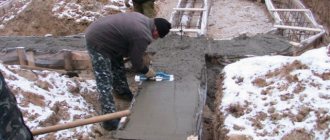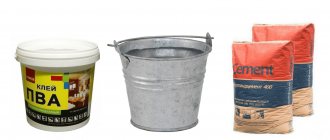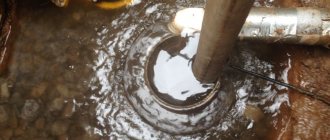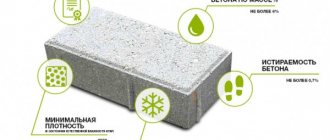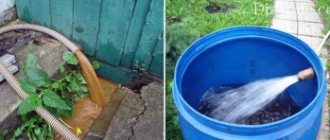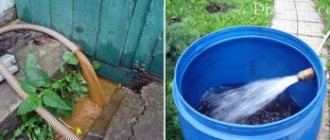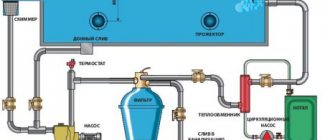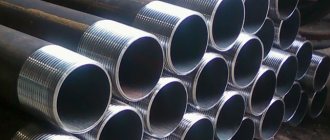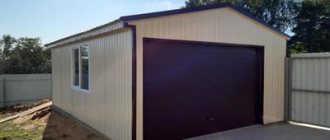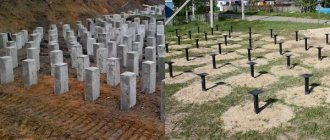The proportions of cement for different types of mortars will be of interest primarily to non-professional developers and repairmen. Professional builders, as a rule, prepare concrete solutions “by eye”, and most often order their delivery to the nearest concrete plant.
Private developers often prefer to save on “anything and everything,” so the proportions of cement in mortars for various purposes will be useful primarily for those who prepare concrete building materials on their own.
Main types of mortars
Depending on the purpose, cement-based mortars are divided into the following widely used types:
- Heavy concrete of different grades.
- Masonry mortars.
- Plaster solutions.
- Solutions for the construction of floor screeds.
- Repair solutions.
The listed different building materials have one common factor - all of the listed building materials contain cement, which is a “binder” that has no analogues.
Considering that readers of the article will find practical information of the following order useful: the proportions of sand and cement for screed, the proportions of sand and cement for concrete, the proportions of cement for screed, the proportions of cement for masonry, as well as the ratio of sand and cement for plaster, we will consider it step by step, indicating specific numbers.
Freezing
The hardening time of the cement coating depends on the class of concrete being strengthened, temperature and humidity.
| Concrete strength class | Temperature, °C | Humidity, % | Freezing time, hours |
| AT 10 | 15-25 | 60-80 | 10 |
| B15 | 15-25 | 60-80 | 7 |
| B25 | 15-25 | 60-80 | 4 |
You can step on the reinforced surface within a day. It will gain average hardness after a week, maximum hardness after 28 days.
Correctly performed treatment with cement laitance, in compliance with technological requirements, extends the service life of concreted and plastered surfaces and brickwork. Keeps them even and smooth. Improves water-repellent properties.
The ratio of sand and cement for floor screed
Floor screed can be used as a basis for laying a finished floor made of boards, plywood, laminate, parquet, solid boards, USB boards, ceramic tiles, mosaics, porcelain tiles and soft materials (carpet, linoleum, carpet runners and rugs).
Floor screed is also used as a “finish” floor covering in utility buildings and rooms with high humidity: bathrooms, bathrooms, saunas, baths and kitchens.
On the Internet and in private conversations, you can read and hear a variety of options on how to properly mix cement with sand in proportions for floor screed. At the same time, there are practical rules and proportions for preparing the solution that can be applied to the vast majority of cases.
For 99% of screed options, it is recommended to use a cement-sand mortar of grade M150 or M200 based on the most affordable cement grade TsEM I 42.5N PTs or TsEM I 52.5N PTs. The outdated designations of these brands of parliaments are M400 and M500.
The ratio of cement and sand for the floor can be seen in the table:
| Brand of solution | M400 cement proportion | Sand proportion | Solder proportions |
| M150 | 1 | 3,0 | 1,3 |
| M200 | 1 | 2,5 | 1,0 |
| Brand of solution | M500 cement proportion | Sand proportion | Solder proportions |
| M150 | 1 | 4,0 | 1,3 |
| M200 | 1 | 3 | 1,0 |
Mix with liquid glass
Liquid glass is actively used as an additive in cement mortars . It accelerates hardening and increases resistance to moisture penetration. Liquid glass is a solution of sodium or potassium silicate, which is produced by high-temperature treatment of soda and quartz sand. Liquid glass is introduced into the solution during the construction of foundations, swimming pools, hydraulic structures, arrangement of furnaces, and screeding. It is indispensable for preparing plaster with high adhesion. Proportionally mixed glass and cement give the solution fire- and acid-resistant properties . The use of liquid glass requires concentration, because deviations lead to unpredictable changes in characteristics. The use of liquid glass is carried out in accordance with the following recommendations:
- The use of liquid glass as a waterproofing additive makes it possible to produce waterproof plaster. It is necessary to use a 15% composition, mix it with a sand-cement mixture in a ratio of 2.5 to 1.
- Waterproofing swimming pools requires observing the following proportion: one portion of silicate is required for 10 parts of the mixture.
- For a mixture of cement, sand and liquid glass, used as a protective composition in the manufacture of wells, the proportions used are 1:1:1.
- Concrete intended for solving household problems should not contain more than 10% liquid glass of the total weight of the solution.
- Preparation of coating compositions implies compliance with the following proportions: 1.5 parts of liquid glass, 1.5 parts of cement and 4 parts of sand, the share of water is no more than 1/4 of the volume of the additive.
- The preparation of ordinary concrete requires a concentration not exceeding 3% of the total volume.
Liquid glass. Photo by Maxidom
To prepare a solution with liquid glass, you must follow the following sequence of operations:
- a glass of silicate is added to one bucket of clean water;
- the components are mixed until the product is completely dissolved;
- during the stirring process, a dry cement-sand mixture is introduced;
- The mass is whipped until smooth.
It is important to remember that the duration of hardening is inversely proportional to the proportion of silicates in the composition.
Ratio of cement and sand for concrete
The concept of “concrete” combines a number of different building materials prepared on the basis of different cements and different fillers. Without going into details, it is worth noting that in private construction, in 99.9% of cases, heavy concrete of certain grades is used.
Therefore, information about special types of concrete will be educational, but has no practical significance. Therefore, within the framework of this article, the ratio of the main components of heavy concrete of popular grades, which are widely used in private construction, is given.
The main brands of heavy concrete include the following names: M150, M200, M300 and M400. These are the most popular options, covering 99.9% of the needs of private developers. The following table of the ratio of components that must be used to prepare 1 m3 of solution tells how to prepare the indicated grades of concrete.
| Concrete grade | Cement CEM I 42.5N PC, kg | Sand, kg | Crushed stone, kg | Water, l |
| M150 | 215 | 735 | 1135 | 190 |
| M200 | 255 | 715 | 1125 | |
| M300 | 335 | 670 | 1105 | |
| M400 | 420 | 625 | 1085 |
| Concrete grade | Cement CEM I 52.5N PC, kg | Sand, kg | Crushed stone, kg | Water, l |
| M150 | 190 | 755 | 1135 | 190 |
| M200 | 225 | 735 | 1125 | |
| M300 | 290 | 705 | 1105 | |
| M400 | 355 | 675 | 1085 |
The consumption of components per 1 cubic meter of concrete is a generally accepted norm and generally accepted equivalent. If, according to construction conditions, it is necessary to prepare an amount of concrete less than 1 m3, you can take the material consumption per 1 m3 as 100% and decide the proportion to find out the required value in kg.
For example. It is necessary to mix concrete grade M150 in an amount of 0.3 m3 based on cement M400 1 m3 - 100%, 0.3 m3 - X%. We solve the proportion: 0.3x100/1=30%(0.3). Multiplying the tabulated values of the amount of materials by 0.3, we get: 64.5 kg of cement, 220.5 kg of sand, 340.5 kg of crushed stone and 57 liters of water, required to prepare M150 grade concrete based on M400 cement.
How to mix concrete by hand without a concrete mixer in 8 steps
The concrete mixer does an excellent job of mixing concrete (also called “concrete mixer”), thoroughly mixing components such as cement, sand and crushed stone, and giving good results. But is it possible to mix concrete by hand without a mixer? The answer is yes, but with a little effort and caution.
You may need to make a concrete mix to install gates, fence posts or foundations. All you need is materials, a shovel, a couple of buckets and a piece of film or old iron to protect the soil and mortar from excess dust and dirt.
How to mix concrete?
Spread plastic wrap over the ground or something more durable.
Pour crushed stone and sand onto the film.
Cement on top of a pile of sand and rubble.
Mix the materials with a shovel. Create a new pile nearby and repeat several times.
Spread the pile out and create a crater in the center. Fill with water.
Pour the mixture into the center of the pile and mix with water.
What is cement?
It is the binding ingredient of sand and coarser aggregate such as crushed stone to make a composite material called concrete. Separately, these components have no real strength, but when they are mixed they create a strong material. The cement simply glues the filler together, and the stone gives the concrete compressive strength.
There are several types of cement. For example, Portland cement and slag cement.
Portland cement is made by baking limestone in kilns and grinding clinker.
Blast furnace slag cement is produced from waste from the metallurgical industry.
Crushed stone is produced in quarries of crushed foam rock, and then the result is sorted by passing through a sieve. In theory, crushed stone should make concrete better than rounded stone - gravel, due to the sharp angular edges.
Concrete mixing solutions
B20 / M250
Concrete mixture grade M250 (general purpose) is suitable for low-rise construction of all types:
production of strip and pile foundations,
concrete floors on reinforced frame,
paths and parking areas
The components are mixed by volume without weight. Ideally crushed stone with a size of 15-20 mm.
Table of characteristics of popular concrete mixtures
According to GOST 26633-91 “Heavy and fine-grained concrete.
How much water will concrete need?
The maximum permissible volume of water that must be added to cement is 0.55 times the weight of the cement itself. Below is the formula for a 50 kg bag of cement:
50 x 0.55 = 27.5 kg / at a temperature of 20 degrees Celsius 27.5 kg = 27.5 l.
The mixture should not be too thin and should be able to support itself without running.
A big mistake when making concrete mix at home is adding too much water.
Water increases mobility, but reduces the strength of the concrete itself, so it is necessary to observe W/C (optimally 0.4 - 0.6 = 40 - 60% of the volume of cement), excess water creates pores that reduce strength.
To increase mobility and workability, I advise you to use plasticizers.
What does strength class B20 mean?
This means that class B20 concrete with a specified strength of 25.69 MPa will in 95% of cases withstand a compressive force (more correct pressure) of 25.69 newtons per square millimeter (2.6197 kgf / mm²) without failure.
So, theoretically, for a cube of size 150 × 150 and thickness 150 mm:
Area = 150 mm x 150 mm = 22500 mm².
The total compressive force that concrete will withstand without crushing is calculated by the formula:
25.69 MPa x 22500 cm² = 578025 newtons. (pressure x area = force).
578025 newtons / 9.80665 MPa = 58,942.1464 kgf/cm² or 59 tons per square 15 cm by 15 cm.
In reality, a concrete slab would crack with much less load than this value. This is because the bottom plane of the slab is not supported equally under each point. This actually refers to the compressive strength of a concrete cube of 150 mm sides obtained from the testing equipment.
Tools for mixing concrete by hand
Construction shovel or construction trowel
Three construction buckets of 20 liters each. One for cement, one for sand and crushed stone and the last one for water. The cement bucket must be kept dry and do not use it for other components.
Cement proportions for masonry
In general, mortars for laying brick, foam block, cinder block, shell rock or limestone include the following components: cement CEM I 32.5N PC (M300) or cement CEM I 42.5N PC (M400), fine sand, lime and water.
In this case, lime is added to give strength and “warmth” to masonry joints and is an “optional” component. However, if the developer wants to obtain high quality (strength, durability and thermal insulation) of the masonry, it is worth going to small additional costs and preparing a lime mortar for masonry in accordance with the table of the number of components per 1 m3 of masonry mortar:
| Brand of masonry mortar | Cement CEM I 42.5N PC (M400), kg | Sand, kg | Lime, kg | Water, l |
| M50 | 170 | 1445 | 205 | 230 |
| M75 | 235 | 1395 | 165 | |
| M100 | 290 | 1365 | 133 | |
| M150 | 380 | 1305 | 75 |
| Brand of masonry mortar | Cement CEM I 32.5N PC (M300), kg | Sand, kg | Lime, kg | Water, l |
| M50 | 220 | 1410 | 175 | 250 |
| M750 | 305 | 1365 | 125 | |
| M100 | 370 | 1305 | 85 | |
| M150 | 485 | 1235 | 15 |
The ratios of cement and sand given in the table for laying brick, cinder block, foam block, shell rock and limestone, using the “proportions” technology, can be recalculated for volumes of material smaller than 1 m3.
Schematics for mixing components
First, a dry consistency is prepared, sifted through a special sieve. This will ensure the homogeneity of the component base. It is advisable to mix using a concrete mixer or drill with an attachment. Further actions:
- The liquid should be added so that it is slightly less than the binder powder.
- Then a plasticizer (detergent) is poured into the consistency.
- Work with a concrete mixer for 2-3 minutes.
- After this, you can gradually add water to obtain a creamy mass.
The proportionality of the component base can change based on what the characteristics of the building material should be.
The ratio of cement and sand for plaster mortars
Manufacturers and retail chains offer consumers a wide selection of ready-made dry plaster mortars of different brands, for various tasks and operating conditions. At the same time, given the high cost of dry mixes, prudent developers prefer to purchase sand and cement separately, prepare the plaster mortar on their own and save at least 50% of the price of the purchased mortar.
The only question that needs to be answered is: how to dilute cement for plaster with sand and water? In general, the following grades of cement-sand mortars are used for plastering work: M50, M100 and M150. Scope of application of solutions:
- M50. Grouting the surface layer before applying the finishing coat.
- M100. Interior decoration of walls operating under standard air humidity conditions.
- M150. External finishing of facades, plinths and finishing of walls working in conditions of high environmental humidity.
How to properly dilute cement with sand for various brands of plaster mortars based on cement TsEM I 42.5N PTs or TsEM I 52.5N PTs in the amount of 1 m3 of “usable”, see the following table.
| Brand of plaster mortar | Cement CEM I 42.5N PC, kg | Sand, kg | Water, l |
| M50 | 225 | 1430 | 285 |
| M100 | 335 | 1345 | |
| M150 | 450 | 1265 |
| Brand of plaster mortar | Cement CEM I 52.5N PC, kg | Sand, kg | Water, l |
| M50 | 210 | 1445 | 285 |
| M100 | 305 | 1375 | |
| M150 | 400 | 1300 |
It is worth noting that the above tabulated values for the ratio of mortar components are valid, including the ratio of sand and cement for tiles in terms of the grade of mortar for rooms with high humidity (M150).
Sand cement water ratio for repair work
The term “repair” work means sealing cracks in walls, restoring the collapsed part of external or internal plaster, restoring the wall of a building made of slag concrete and other similar work.
Considering the small volumes of “repair” material, the following ratio “cement: sand: water” can be used here, ideally suited for all possible cases: 1 part cement CEM I 42.5N PC or CEM I 52.5N, 3 parts sifted sand and 0 .5 parts water. The repair material prepared according to this recipe has proven its effectiveness and durability.
Do I need to add supplements?
The reinforcing layer, made of pure cement, begins to crumble and peel off during use. To prevent the appearance of this defect, microfiber and components are introduced into the solution to improve the technical characteristics of the coating after hardening.
| Additive to the composition | What is it for? |
| Lime milk (maximum 10% of the total mass of the solution). | Increases plasticity. |
| Sodium aluminate (1% by weight of dry cement). | Increases moisture resistance. Repels dust. |
| Corundum, quartz or granite filler (no more than 1%). | Increases hardness. |
| Liquid glass (10% by weight of cement mortar). | Strengthens adhesion, accelerates setting, increases fluidity, and ensures water resistance. |
Added strictly according to the additive manufacturer's instructions.
